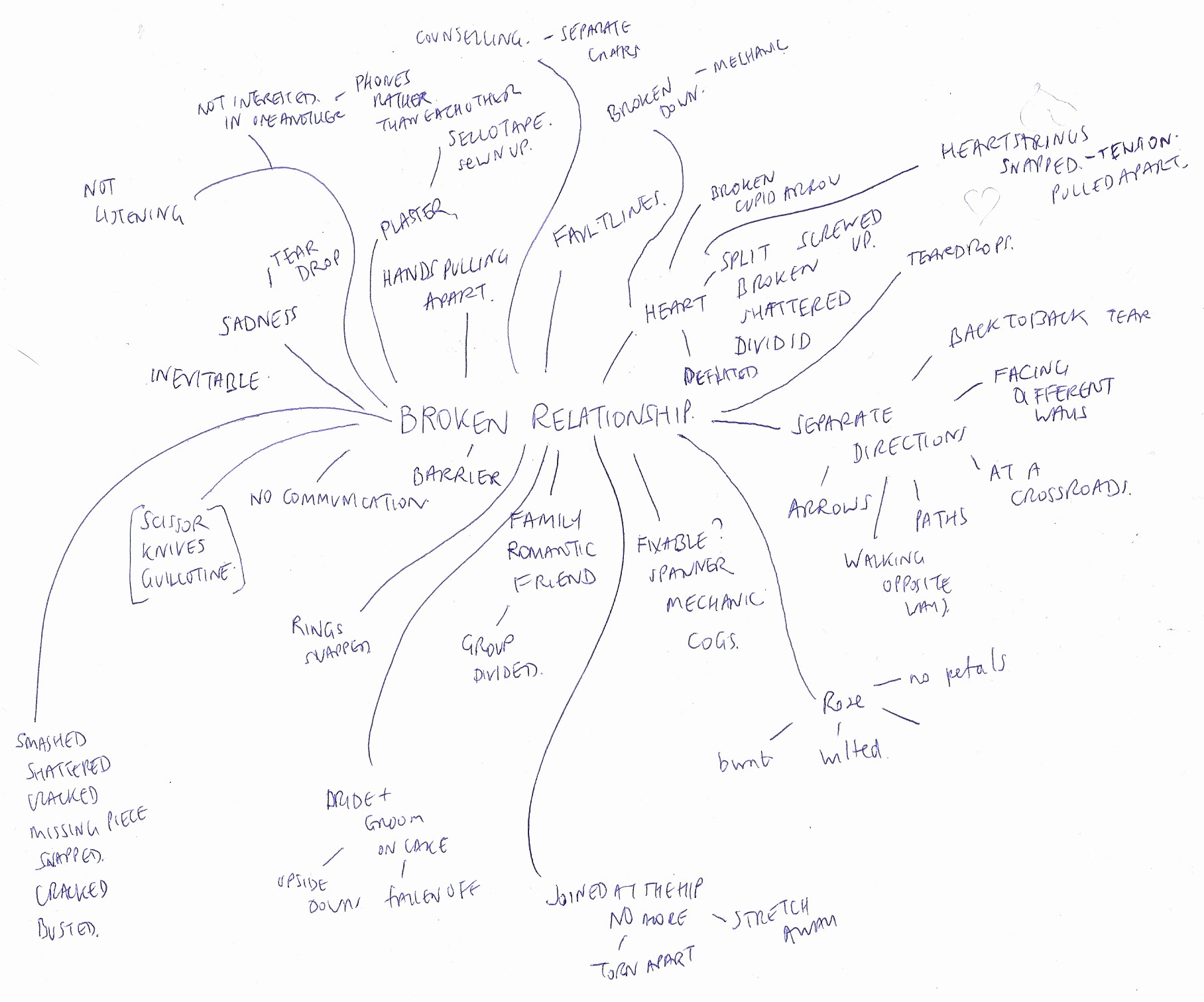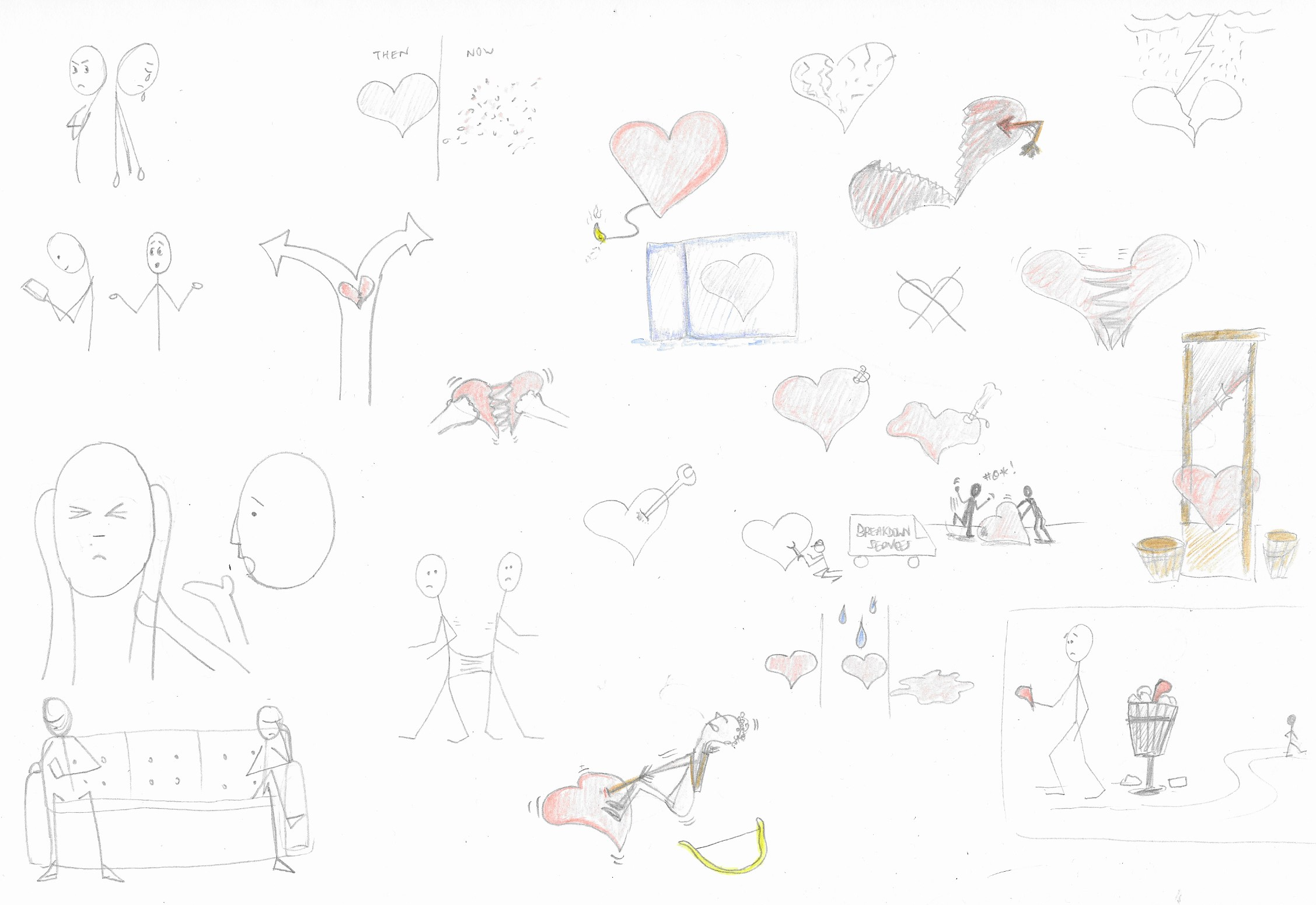Brief
Collect as many examples of visual metaphor as you can find. Often metaphors are used within political and issue-based works to give complex or subtle ideas greater clarity. For this reason you are likely to trace them more easily within editorial contexts: newspapers and articles in magazines.
- Reaching retirement
- Dreams of romance
- Broken relationship
- Censorship of the press
- High achievement
- Economic catastrophe
Choose from one of the phrases above and create a drawn visual list of objects and subjects which could be used to symbolise them. You may find that it is in the way that the symbol can be modified that you can convey your idea most effectively. Don’t be overly concerned with the aesthetic quality or technical accuracy in the drawing. See this as an extension of your visual shorthand. If you find it useful, make a spider diagram around the phrase to generate other words, which will bring other visual connotations.
Show your drawings to someone else to check their understanding of the meanings in your drawings and gauge how far your drawings communicate what you intended.
Research
I started this exercise by trying to clarify my understating of the term ‘metaphor’. I watched a TedEd lesson by Jane Hirshfield called The Art of the Metaphor. This was very helpful as it explains the term in a visual way.
Then I found a YouTube video Visual Metaphors: an academic study, which is about a project to compare how we understand metaphors in images and those in language. I found it really interesting and helped me understand more in depth about how metaphors are processed.
Next I read through some articles specifically explaining visual metaphors (links in Resources below) before moving onto collating some examples.
I set up a Pinterest board and pinned some examples. I tried to only select ones that had little or no text as I wanted to focus on the power of communication via the image rather than it needing to be explained with words.
I then identified some specific artists I liked whose work is often based on metaphors:
Clet Abrahams – this French street artist takes everyday objects, such as street signs, and adds characters or features that are either humorous or make a point about current issues. The ideas appear to be be so simple, but are really clever, in my opinion, and their message is conveyed quickly and easily to the viewer.
Duy Huynh – this Vietnamese-American artist bases his artworks on particular phrases or words. I felt they required some thought and seem quite ‘dream-like’ in style.
Pawel Kuczynski – this Polish artist was my favourite find. He works make comments on current issues, but sometimes with added humour. I particularly liked his pieces that focus on the relationship between humans and animals (i.e. eating them), but I thought each one was very thoughtful and communicated their intended message succinctly. I spent a long time looking at a selection of the artworks and contemplating each one. I continued thinking about them afterwards as well.
Drawing the Phrase ‘Broken Relationship’
The phrase I chose for this exercise was ‘Broken Relationship’. I decided to mind-map the phrase to see what ideas this would lead to and I found this helpful.

I then moved onto the drawing part of this exercise. As stated in the brief, I tried not to concentrate on aesthetic quality/technical accuracy of the them, but rather the message I was trying to convey.

I think some of my attempts were more successful than others. I’m not sure if they had to specifically convey the phrase ‘broken relationship’ so that someone would think of those two words exactly or if it rather it could be connotations of the phrase. If it is the latter, then a few of the drawings achieved this.
I found this exercise very interesting. I enjoyed doing the research and learnt a great deal – it made me think about the use of metaphors both in language and art. I identified several artists that really appeal to me. I liked the challenge of thinking up my own visual metaphors and having to try and communicate their intention clearly to another person without having to verbally explain it.
Resources
Bolognesi, M. (2015). Visual Metaphors: an academic project. (video) Available at: https://youtu.be/aAaAheCKOng [Accessed 2 July 2020].
Clet Abrahams, (n.d.). Clet Abrahams. [online] Available at: http://www.clet.com [Accessed 3 July 2020].
Duy Huynh, (n.d.). Duy Huynh – Selected Archives. [online] available at: https://www.duyhuynh.com/artwork/duy-huynh-selected-archives/ [Accessed 3 July 2020].
Hirshfield, J (n.d.). The Art of the Metaphor. (video) TEDEd. Available at: https://ed.ted.com/lessons/jane-hirshfield-the-art-of-the-metaphor#watch [Accessed 2 July 2020].
Kaczynski, P. (n.d.). Pawel Kaczynski. [online] Available at: http://pawelkuczynski.com/Strona-g-owna/Home/ [Accessed 3 July 2020].
Picturem, (n.d.). Pawel Kaczynski – Art Collection. [online] Available at: https://www.pictorem.com/profile/Pawel.Kuczynski?records=1 [Accessed 3 July 2020].
ThoughtCo., (n.d.). Visual Metaphor. [online] Available at: https://www.thoughtco.com/visual-metaphor-1692595 [2 July 2020].